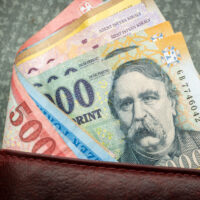Hungary March inflation slows to 2.7 pc
Budapest, April 11 (MTI) – Consumer prices in Hungary grew by an annual 2.7 percent in March, slowing from 2.9 percent in February, the Central Statistical Office said on Tuesday.
Emerging market analysts in London had forecast headline inflation between 2.8 percent and 3.3 percent.
KSH department head Borbála Minarik attributed the slower pace mainly to the monthly decrease of fuel and tobacco prices.
On a seasonally and working day-adjusted basis, consumer prices were unchanged month on month after rising by 0.4 percent in February.
Two of the National Bank of Hungary’s three inflation indicators rose but the measures of underlying inflation “did not change any significantly from the previous month and continued to stay in the 1.5-2.0 percent range”, the central bank said in a monthly assessment on Tuesday.
The indicator for core inflation, excluding indirect tax effects, was 1.9 percent in February, rising from 1.8 percent in the previous month. Of the underlying measures, the indicator for demand-sensitive inflation, which excludes processed foods from core inflation, was 1.5 percent, edging down from 1.6 percent, while the indicator for sticky price inflation, which includes items for which retail prices vary, on average, no more than 15 percent a month, rose to 2.0 percent from 1.9 percent.
Seasonally adjusted core inflation, which excludes volatile fuel and food prices, was reported by the KSH as rising by an annual 1.8 percent, unchanged from February.
“In March, mainly changes in the prices of the more volatile items with greater sensitivity to cost changes, i.e. food and energy, had an upward effect on prices,” the NBH said.
“Households’ inflation expectations have been broadly unchanged in recent months and remained at moderate levels, in line with underlying inflation developments,” it added.
The KSH reported January-March consumer prices up by 2.6 percent from a year earlier.
Hungary’s annual inflation, harmonised for better comparison with other European Union member states, was 2.4 percent.
Analysts told MTI that inflation would temporarily exceed 3 percent in the remainder of the year while averaging 2.5 percent in the full year.
K and H Bank analyst Dávid Németh expected the central bank to stick to its present loose monetary policy and further reduce the limit on its three-month deposits in July. Németh forecast 2017 average annual inflation at between 2.5 percent and 2.6 percent.
Gergely Suppán of Takarékbank forecast average inflation this year at 2.4 percent but did not rule out a higher rate given accelerating domestic demand and wage expenses. CPI could near 3 percent at the start of 2018 as VAT cuts drop out of the base, he added.
Source: MTI
please make a donation here
Hot news
Hungarian researchers’ new methodology for replacing GDP: the sustainability turnaround
Russia’s vision for Ukraine in 2045 might include Hungary – What’s the endgame for Moscow?
Orbán cabinet announced considerable wage rise in this sector
Disturbing VIDEO emerged of the murdered American woman’s last hours: she walked hand in hand with her alleged killer
Dozens of Budapest technological university BME researchers on the Stanford list
Top Hungary news: winter is here, Romania joins Schengen, American woman’s murder details – 23 November, 2024





